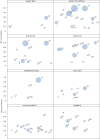Measuring pesticide ecological and health risks in West African agriculture to establish an enabling environment for sustainable intensification
- PMID: 24535399
- PMCID: PMC3928896
- DOI: 10.1098/rstb.2013.0491
Measuring pesticide ecological and health risks in West African agriculture to establish an enabling environment for sustainable intensification
Abstract
We outline an approach to pesticide risk assessment that is based upon surveys of pesticide use throughout West Africa. We have developed and used new risk assessment models to provide, to our knowledge, the first detailed, geographically extensive, scientifically based analysis of pesticide risks for this region. Human health risks from dermal exposure to adults and children are severe enough in many crops to require long periods of up to three weeks when entry to fields should be restricted. This is impractical in terms of crop management, and regulatory action is needed to remove these pesticides from the marketplace. We also found widespread risks to terrestrial and aquatic wildlife throughout the region, and if these results were extrapolated to all similar irrigated perimeters in the Senegal and Niger River Basins, they suggest that pesticides could pose a significant threat to regional biodiversity. Our analyses are presented at the regional, national and village levels to promote regulatory advances but also local risk communication and management. Without progress in pesticide risk management, supported by participatory farmer education, West African agriculture provides a weak context for the sustainable intensification of agricultural production or for the adoption of new crop technologies.
Keywords: food security; pesticide regulation; risk assessment; sub-Saharan Africa; sustainable intensification.
Figures


References
-
- Van der Werf HMG. 1996. Assessing the impact of pesticides on the environment. Agric. Ecosyst. Environ. 60, 81–96. (10.1016/S0167-8809(96)01096-1) - DOI
-
- Devine DJ, Furlong MJ. 2007. Insecticide use: contexts and ecological consequences. Agric. Hum. Values 24, 281–306. (10.1007/s10460-007-9067-z) - DOI
-
- Jepson PC. 2009. Assessing environmental risks of pesticides. In Integrated pest management: concepts, strategies, tactics and case studies (eds Radcliffe EB, Hutchinson WD, Cancelado RE.), pp. 205–220. Cambridge, UK: Cambridge University Press.
Publication types
MeSH terms
Substances
LinkOut - more resources
Full Text Sources
Other Literature Sources
Medical

